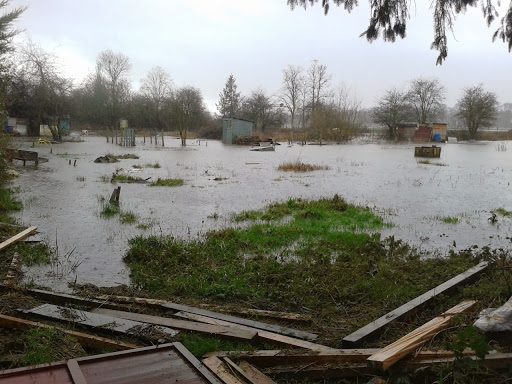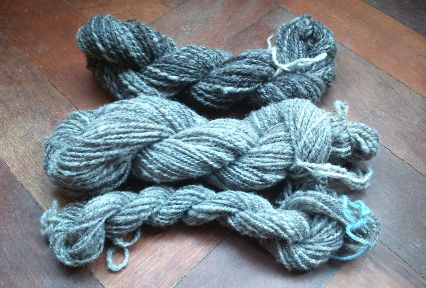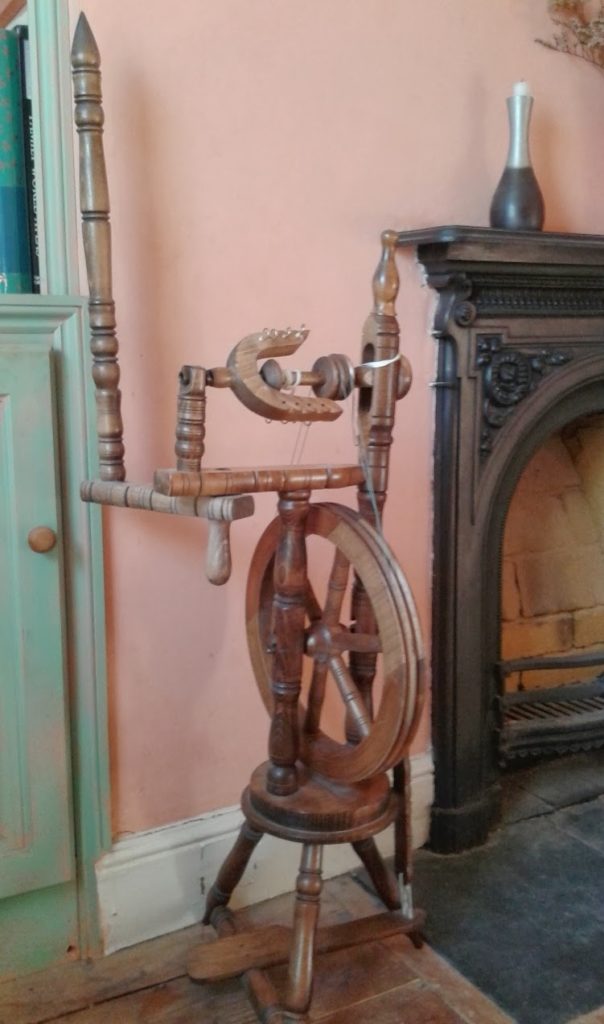Being a free-range spinner is one of the main advantages of spinning on a drop spindle. It’s like scribbling notes in a notebook, rather than being at your desk. You and your work are portable – you can be anywhere. With dexterity, you can also multi-task. I could be a nomadic spinner with a drop spindle, but in reality lately, extremely wet weather has kept me at home. No matter, though, because roaming with the spindle around the house still has its advantages.
Spinning and Watching the Water Levels Fall
We’ve had a wet time of it lately. If you’re in the UK you’ll know as it has dominated the news. Here, wind and rain has swept up from the south-west over wet and soaking Somerset (the wettest part of the country) and rain landing on the Welsh hills has flowed down the River Severn and and graced the floodplains of Worcestershire. The Jet Stream has been up to its tricks again, flooding us over here and freezing everyone in the northern US and Canada. Knitters of North America – you must have appreciated your handmade knits (at least you can weather the freeze in style!).
In my post about The Case of the Disappearing Dyers Rocket, last year, I debated whether my site for picking dyer’s rocket had been knocked back by the shallow and minuscule 2012 floods. I said that I would have had to have snorkled to get to my allotment shed that winter- two weeks ago I would definitely have had to swim. This is the allotment site when the flood levels were on the rise, well before they hit their peak, and when I could still reach the allotment gate. Judging by 2007 levels (the last big flood) the water level will have got to at least half way up the green shed in the distance (mine).

Still, at least it isn’t my house. My sympathies to those in Somerset and Berkshire (and elsewhere) who are still mopping up.

Scouring Experiments
Throughout the wet weather (which has now mostly blown away) I was spinning my way through as much cleaned and carded fleece as I could, wandering to the window every now and again, spindle in hand, to see if the rain had stopped.
Cleaning (scouring) and spinning my large stock of Ryeland fleece is an ongoing activity, particularly as it is now starting smell a little sheepy! For the white fleece, I’ve been trying to find the balance between very clean, white fleece and ‘just about’ clean, creamy coloured fleece.
To begin with I was trying to tease out every last bit of dirt (by teasing out the ends floating under water), but it takes some time. Then I came to accept that, to a degree, some dirt falls out by chance when carding, and then a final wash of the spun yarn whitens the yarn a little further. Not washing out every last bit of dirt also keeps some of the oil in and the yarn a little softer. I’ve experimented with hot scouring and cold scouring. It’s all a process of learning what suits. I suspect there is never a balance that always works, rather, it’s likely to change depending on the project.
I’ve been alternating between spinning grey and white fleece. Grey for a crochet poncho (double knit/light worsted weight) and white at approximately 4 ply or sport weight for a lacy knit vintage top and eventually an heirloom shawl. I’m taking the long view here: I know it’s going to take some time.

Handspun Ryeland yarn
I have a new lightweight 20g top whorl spindle for the finer yarn.
Drop Spindle Manoeuvering
So far, I’m mainly a spindle spinner. Like most, when I decided to take up spinning (because of my love of wool and all things woolly) I started on a drop spindle but then stayed with it, as my only means of spinning for quite a while before I tried a wheel. I could say that it was because it took a while before finding a spinning wheel to buy, but I don’t think that was entirely true. There is something about a simple tool that produces something so useful and becoming.
I started spinning by teasing out fleece and twisting it on a crochet hook. I already had some fleece. In fact, huge quantities of the stuff, so I fiddled around with it while waiting to attend a beginners spinning course. I didn’t want to buy a drop spindle until I’d found out more about them. I easily adapted to the drop spindle at the workshop (hand-eye co-ordination having been trained to a degree) but came a cropper when it came to the spinning wheel. Hand-eye-foot co-ordination foxed me that day. Since then I have bought a second-hand wheel, and with the help of a spinning friend, I have actually learnt to use it. It is a flax wheel though, and not the easiest wheel for spinning wool, particularly short-staple wool.

I also have limited working space at the moment, so there I am, with my bag of spindles. I’m reading two books – Respect the Spindle by Abby Franquemont and Spinning in the old way by Priscilla A Gibson-Roberts and agree with many of the pro-spindle sentiments. I can walk around with them, spin standing or sitting, propped up against a radiator on a cold day – keeping an eye on a pot simmering on the cooker. Often, I go and stir the simmering pot, make a cup of tea one-handed with the spindle in hand. I can adjust degree of twist and thickness easily. I’ve also taken them away with me, and have even sat spinning on the forecourt of Birmingham New Street station late at night, waiting for a train.
With more space (in the future) I may take to the spinning wheel more, but the spindle is undeniably a most versatile, miniature, portable tool and will always have its place.
